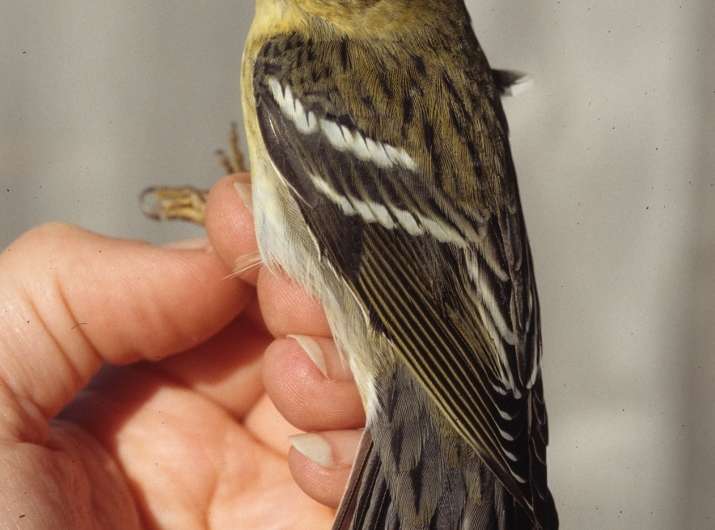Forty years of data on furthest-migrating warbler reveals new insights

Tiny Blackpoll Warblers have the longest migratory route of any New World warbler, making a nonstop flight over the Atlantic Ocean each fall from New England to northern South America each year, but a study forthcoming in The Auk: Ornithological Advances shows that individuals that breed in western North America migrate east first to fatten up before migrating across the water. Pulling together data on more than 22,000 individual birds from 13 different sites in the U.S. and Canada, the study's authors have provided new insights about one of the most impressive bird migrations in the Americas.
To learn more about the patterns of Blackpoll Warblers' (Setophaga striata) fall migration on a continental scale, Sara Morris of Canisius College and her colleagues analyzed data on 22,295 individual birds banded in North America in the last four decades. They found that western-breeding birds leave their summer homes earlier than eastern-breeding birds do in order to make their even longer journey, crossing the continent west to east before heading south across the Atlantic, which leaves them a shorter amount of time each year to nest and raise their young. Adults, with their greater experience, travel more quickly and tend to be in better condition than younger birds, experiencing less mortality. The timing of fall migration has also been moving back by about a day each decade, which the authors speculate may be due to climate change.
"We tend to focus on Blackpoll Warblers' transoceanic flight—when we think about fall migration, we think about them going over water. But one of the things that we hope people will think about as a result of this paper is the fact that the birds that are breeding in the west, particularly in the Northwest Territories or in Alaska, are also migrating all the way across the continent," she adds. "They need tremendous resources in order to build the fat stores that are required for a successful flight, and it's a real reminder of the need for the conservation of habitats for them to be able to find the places that they need to build up these fat stores."
"Migration is one of the most understudied, important, and perilous times in a songbird's life cycle. Morris et al.'s research is a rare, range-wide examination using valuable long-term banding data to rigorously identify factors that influence migration for a declining songbird, the Blackpoll Warbler," according to William DeLuca of the University of Massachusetts, the lead author of the recent study that used geolocators to confirm the species' incredible oceanic migration route. "This research is an excellent contribution toward understanding one of the most amazing migratory feats on the planet."
Gathering the data was a large undertaking, but having both American and Canadian researchers working on the study helped open doors. "We contacted a variety of different individuals and stations and they were all unbelievably generous in allowing us to use their data as part of the project," says Kristen Covino, one of Morris's coauthors. "There were definitely some forms we had to fill out along the way, and a lot of individual contacts—as you might expect, everyone wants to know how their data is going to be used and make sure that it's going to be appropriately recognized—but it was really amazing to see what kind of response we had to our requests."
More information: 'Autumn migratory patterns of the Blackpoll Warbler at a continental scale' will be available Dec. 9, 2015 at www.aoucospubs.org/toc/tauk/133/1
Provided by The Auk



















